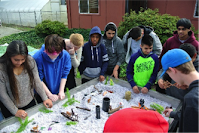The Sustainable Schools and Clean Water programs at RE Sources for Sustainable Communities joined forces this fall to launch Young Water Stewards for high school students in rural Whatcom County, helping them develop an understanding of their local watersheds and how to be a steward of clean water.
A watershed is a drainage basin that funnels water into a lake, river, or bay. Everyone lives in a watershed, which means our choices impact the health of our waters.
This fall, 175 high school students from Lynden and Ferndale participated in the Young Water Stewards training. Students learned how watersheds function through an interactive watershed model, learned how to conduct water quality testing, toured their local watershed to learn about different types of pollution, learned tips for how to protect the health of their local watershed, and took part in a stewardship project.
Field notes
After getting their hands dirty with the interactive watershed model, students boarded a bus for a comprehensive tour of their local watershed. Both the Fishtrap Creek and Schell Creek watersheds in Lynden and Ferndale, respectively, have been identified by Whatcom County as having high levels of pollution, making them the perfect case studies for these Young Water Stewards.
“We must keep the watershed protected and clean for everything to survive.” (Kiera, Ferndale High School)
 As the bus trundled along, students learned how rainwater can carry different types of pollution into nearby lakes, rivers, and bays. Stops at several bridges helped students gain a unique perspective on how pollution from residential and industrial areas can impact water quality, and how bacteria from pet waste and farm fields can run off into waterways.
As the bus trundled along, students learned how rainwater can carry different types of pollution into nearby lakes, rivers, and bays. Stops at several bridges helped students gain a unique perspective on how pollution from residential and industrial areas can impact water quality, and how bacteria from pet waste and farm fields can run off into waterways.
An extended creekside stop taught students how to use scientific tools and measurements to analyze water samples, exposing new scientific concepts for watershed health, including dissolved oxygen, turbidity, temperature, and pH.
“I like how we learned so many different things, like riparian buffers or dissolved oxygen, yet it all ties in together.” (Lauren, Ferndale High School)
The watershed tours and water quality sampling exercises provided a unique opportunity to make abstract ideas become more concrete, challenging students to think about the health of their local watershed and how different types of land use — from cities to farms to neighborhoods — can impact watershed health.
“It’s interesting to see how pollution can affect aquatic life.” (Student, Lynden High School)
 After returning to school, the students took their new knowledge and discussed the importance of individual and community stewardship actions to keep their watershed healthy. The students brainstormed stewardship projects to help improve their local watershed. Since their high school is also within their local watershed, they didn’t have to go very far to make a difference.
After returning to school, the students took their new knowledge and discussed the importance of individual and community stewardship actions to keep their watershed healthy. The students brainstormed stewardship projects to help improve their local watershed. Since their high school is also within their local watershed, they didn’t have to go very far to make a difference.
Spirits were high as students spent their afternoon outside in the sun, where they pulled invasive blackberry bushes and competed in litter cleanups. Students said they felt like they really accomplished something, whether it was clearing invasive plants from the creek on school property, or picking up more than 100 pounds of trash.
Getting involved in a stewardship project helped the students see firsthand how every person can take action to keep their local watershed clean.
“When we did the stewardship project, it made me feel like we did something good for the school.” (Oliver, Ferndale High School)
 According to student surveys, after participating in Young Water Stewards, nearly every student built some new knowledge of their local watershed, how it works, and why it’s important. Almost three-quarters of students said they enjoyed the project, and almost half said they have an increased or continued interest in pursuing a science-based career. For teenagers, we think these numbers are fantastic and feel lucky to have spent this fall with the students of Lynden and Ferndale.
According to student surveys, after participating in Young Water Stewards, nearly every student built some new knowledge of their local watershed, how it works, and why it’s important. Almost three-quarters of students said they enjoyed the project, and almost half said they have an increased or continued interest in pursuing a science-based career. For teenagers, we think these numbers are fantastic and feel lucky to have spent this fall with the students of Lynden and Ferndale.
More information
Young Water Stewards meets Next Generation Science Standards and includes in-class lessons, a field trip around your high school’s local watershed, water quality sampling, and a culminating stewardship project. The program lasts one week and includes up to 20 hours of direct instruction.
The program hopes to extend to Meridian, Blaine, Mt. Baker, and Nooksack Valley high schools in 2017.
Teachers interested in enrolling in the program, and volunteers interested in chaperoning a field trip or supporting the program, can email schools@re-sources.org or call 360-733-8307 x210.
The program is funded by a grant from NOAA, the National Oceanic and Atmospheric Administration.
Visit the Young Water Stewards program page for more information.
